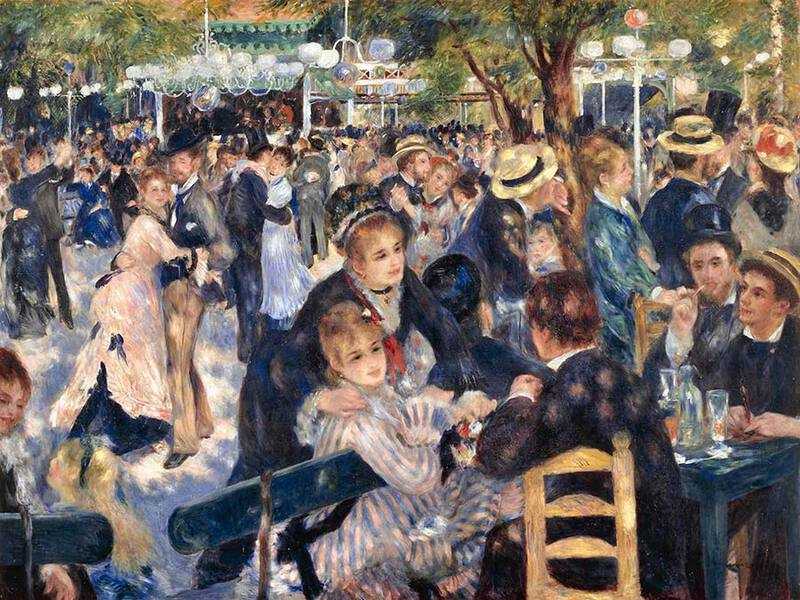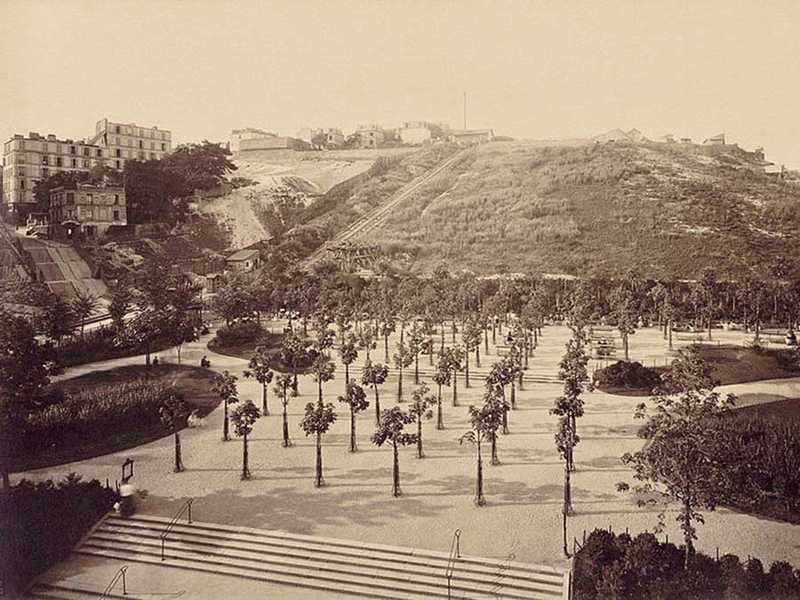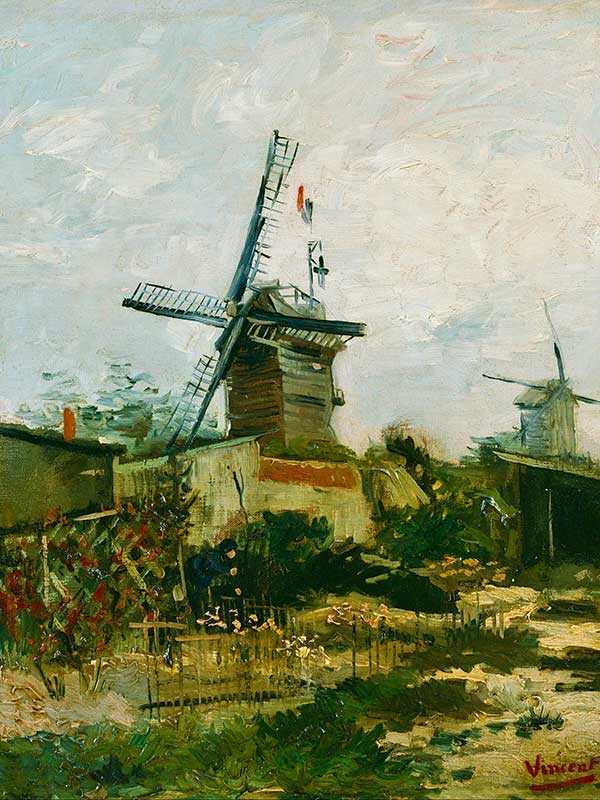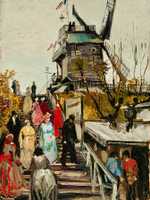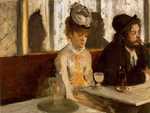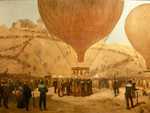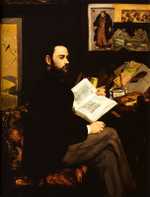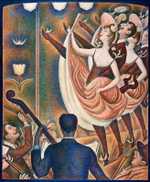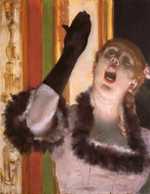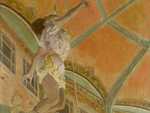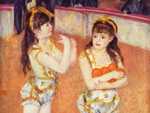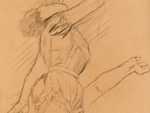1. Impressionism and Montmartre
For centuries, Montmartre had been a village, independent from Paris and outside of the city walls.
However, in 1860 it was absorbed into the new and ever-growing city limits.
Despite the annexation of Montmartre, the neighbourhood still retained a unique and distinctive feel. The hilly landscape made it unsuitable for many of the architectural reforms Baron Haussmann had undertaken elsewhere in Paris and as a result, it held on to the narrow streets, windmills and small, patchwork houses of its past.
Nightlife
Historically known for its religious ties - Montmartre means Martyr’s Mount, named after the martyrdom of Saint-Denis on the hill - Montmartre had gradually gathered a reputation for its nightlife. Wine flowed freely thanks to the vineyards in the area and was not taxed as heavily as inside the city limits.
In other words, Montmartre was the place to go for a great night out!
... and low rents
The low rents and rural beauty of the neighbourhood also drew artists to the area and by the 1860s, large numbers were relocating to Montmartre. This was also helped by its proximity to the École des Beaux Arts, which was situated just across the River Seine.
In Montmartre, artists could interact with ‘ordinary people’ as opposed to the bourgeois circles more dominant in the centre of Paris. This was one of the sources of inspiration for the Impressionists. It was common for artists to recruit young, working-class women from the neighbourhood as models, who often also became their lovers!
Modelling quickly became a popular line of work for many women, often supplementing their income from other jobs in the garment industry.
Setting up studio
Edouard Manet, Edgar Degas, Auguste Renoir, Camille Pissarro and Paul Cézanne all had studios in Montmartre. Their favourite places tended to be at the top of the hill or butte, where the cafés and cabarets were situated.
This was also where the rents were cheapest.
One of the Impressionist’s regular cafés was the Cafe Guerbois in the Rue des Batignolles. It was in Guerbois that Monet first proposed the staging of an independent group exhibition in December 1873.
Similarly, Novelles Athènes in the same area became a popular location for socialising with other artists and writers. This café became the setting for Degas’ 1876 painting ‘L’Absinthe’.
Buying their paints and canvasses
As well as cafés, the artists would often visit paint shops with temporary exhibitions of art on display. One of the most popular of these was Père Tanguy’s paint shop where aspiring artists would spend entire days talking and critiquing the exhibitions.
Tanguy agreed to display some of Vincent Van Gogh and Cézanne’s paintings, one of the few venues in Paris that did, as well as works by Georges Seurat and Paul Gauguin.
Other venues known to display Impressionist work included the Restaurant la Fourche and the Cabaret du Tambourine, both in Montmartre.
2. Montmartre's Dance Halls
Montmartre was known for its dance halls and their fame drew people to the neighbourhood.
The majority of the dance halls were situated on the Boulevard Rochechouart at the base of the hill.
Élysées-Montmartre
Of Montmartre’s dance halls, Élysées-Montmartre was arguably the most famous. This particular dance hall also boasted gambling rooms and a restaurant. It was an important venue for the Impressionists, especially during the 1870s, forming the centre of many social gatherings.
Émile Zola held a party there in 1874 to celebrate his novel ‘L’Assommoir’, about working-class Parisians. Zola also admitted that he had drawn L’Assomoir’s imagery from many of Degas’ paintings from the neighbourhood, saying
“I quite plainly described some of your pictures in more than one place in my pages."
Moulin de la Galette
The Moulin de la Galette was another a dance hall popular among the Impressionists, especially Renoir.
The Galette had long been catering to a working-class customer base but was “discovered” by the new avant-garde arrivals in the neighbourhood and quickly became a hotspot for artists. Named after one of the last remaining windmills in Paris, the Galette was partly open air, with a large garden and trees.
An image of the venue painted from the street can be seen in Vincent Van Gogh’s work of the same name from 1886.
In 1876, Renoir painted ‘Le bal du Moulin de la Galette’, which is now considered to be his most important work from the 1870s. In his painting, Renoir attempts to capture the vibrant energy of the dance hall’s garden on a sunny afternoon. He combined artificial light and natural light in the work, using quick brushstrokes to create a slight blurring effect. The overall energy of the piece is perhaps best described by Gustave Geffroy:
“Le Moulin de la Galette is one of these complete summaries of vital observation and luminous atmosphere: the gayness of the dance, the noise, the sun, the dust of an outdoor celebration – the excitement of faces, the carelessness of poses - a rhythm where pink, light blue, dark blue and black dresses turn and stop – a movement of passion, a winning shadow, a running fire, pleasure and fatigue – all the poor heroines of romance with fine faces, expressive hands, light-hearted attitudes gone, or weary, who express hope, intoxication, abandonment, fierce boredom.”
As well as capturing the energy of Montmartre’s dance halls during this period, Renoir’s piece also highlights the importance of such venues as meeting places for artists and writers. He depicts many of his friends in the scene, including the Cuban painter Pedro Vidal of Solarès, the journalist and critic Georges Rivière, and Franc-Lamy and Norbert Goeneutte, both artists.
Also featured in the work are two actresses and models, sisters Jeanne and Estelle Samary, who dominate the central foreground.
Prostitution
From the 1890s onwards, dance halls became increasingly commercialized. The turn of the century saw Paris’ dance halls reach the highest point of their fame, transformed into one of the largest prostitution markets in all of Europe. The majority of the dancers were also prostitutes and as one visitor described,
“in this place no passions need be curbed.”
As a result of economic drivers, many women who had previously worked in artisanal trades were forced to turn to prostitution in order to make a living. Hence, the 19th century was a period in which prostitution became widespread and a common sight on the streets of Montmartre.
And drugs ...
As well as prostitution, dance halls became a centre for drug trade in Paris. Cocaine and morphine were the most common drugs on sale and drug rackets monopolised many of the district’s dance halls. Opium dens also proliferated in the neighbourhood during this time.
The most famous of Montmartre’s dance halls, whose reputation prevails to this day, was the Moulin Rouge. The Moulin Rouge opened in 1889, aimed at a different market to the cafés and cabarets at the top of the hill. Instead, this enormous venue was aimed directly at wealthy visitors to Montmartre, taking advantage of the reputation of the neighbourhood which was by this point firmly established.
The Moulin Rouge
At the Moulin Rouge, dancers performed raucous shows on the centre stage whilst customers drank and danced themselves. An eroticised version of the can-can, known as ‘le chahut’ was a particularly popular dance where the performers would kick their legs and lift up their skirts to show their underwear.
A depiction of this dance can be seen in Seurat’s pointillist work, ‘Le Chachut’ from 1889. By the 1890s, African American dancers were also performing the cakewalk, helping to popularise a pre-American civil war plantation dance in Europe.
Henri de Toulouse-Lautrec was the Post-Impressionist who is best known for his works set in the Moulin Rouge. He became fascinated with the venue and immortalised the dancers in his paintings. Lautrec was such a fan that he became an almost permanent customer, spending consecutive nights drinking absinthe and socialising with the dancers. Over time, he recreated the raucous world of the dance halls in his art, painting dancers, singers, musicians and prostitutes.
The most notable of these figures was Jane Avril who was a close friend of Lautrec. As Lautrec’s friend, Paul Leclercq described:
“In the midst of the crowd, there was a stir, and a line of people started to form: Jane Avril was dancing, twirling, gracefully, lightly, a little madly; pale, skinny, thoroughbred, she twirled and reversed, weightless, fed on flowers; Lautrec was shouting out his admiration.”
Gay Paree
Not only did Montmartre’s dance halls cater to Parisians but it also became a tourist attraction for visitors from across the world. It was especially popular among American men who saw Montmartre as epitomising their image of “gay Paree”. This was helped in no small part by the increasing popularity of the Impressionists at the turn of the century and the international fame the movement had gathered.
Tourists went in search of the bohemia that the Impressionists had popularised. In this way, the area became more cosmopolitan but also extremely commercial.
3. The Cabarets
Montmartre had a number of cabarets before it became a centre for the Parisian avant-garde.
However, by the 1880s the founding of new cabarets began in earnest. These sought to provide wealthier arrivals to the neighbourhood with the entertainment that they wanted: poetry, music and theatre.
Cabarets offered the elite places where they could “slum”, away from the regulating forces at work in the districts where they lived. The bourgeois audience was almost exclusively male as cabarets were not deemed to be suitable places for “respectable” women to congregate. In cabarets, men could be entertained by popular artists, drink and solicit prostitutes.
The interiors of cabarets were designed to put performers and patrons in close proximity. In contrast to theatres and opera halls, cabarets deliberately encouraged interaction with the audience. Cabaret performers were adept at holding their audience’s attention, providing titillation and amusement.
Edgar Degas
From 1875 onwards, many of Degas’ paintings reflect his fascination with cabarets and café-concerts as he attempted to capture the energy of the stage performers. He played with the effects of artificial light on the faces of his models, the chins highlighted and the eyes shadowed.
He often captured them open mouthed in the middle of a performance, making a dramatic gesture with their hands as in ‘Singer with a Glove’ from 1878.
Cabarets also served as a venue in which emerging artists could display their works and hopefully win sales. Degas, for instance, got his start in cabarets, as did many famous writers including Zola and Alexandre Dumas
The Black Cat (Le Chat Noir)
One of the most loved cabarets of the Impressionists was the Chat Noir or Black Cat, opened by Rodolphe Salis in 1881. Salis was a poet and eccentric character, known for ridiculing visitors to his cabaret and promoting Montmartre as a haven of debauchery.
He is quoted as saying,
“Montmartre the free city, Montmartre the sacred hill, Montmartre the gem of the earth, navel and brain of the world.”
At the Chat Noir, Salis created a home for artists and writers, as well as wealthier patrons who wanted to experience a slice of the fabled bohemianism of Montmartre. The writer Félicien Champsaur described the scene is 1882, writing:
“In this bizarre land swarmed a host of colorful artists, writers, painters, musicians, sculptors, architects, a few with their own places but most in furnished lodgings, surrounded by the workers of Montmartre, the starchy ladies of the rue Bréda, the retired folk of Batignolles, sprouting up all over the place, like weeds.”
The Folies Bergere
The cabaret immortalised in a painting by Manet was the Folies Bergère. Modelled on the Alhambra Music Hall in London, the venue was established in 1869, remaining enormously popular right through into the 1920s. Its success was partly down to its ability to move with the times and cater to what its audience wanted.
Manet’s painting, 'A Bar at the Folies-Bergère’ from 1882, depicts the interior of the cabaret on a busy night. However, his painting is unusual in that it centres on one employee, Suzon. Rather than capture the vibrance and apparent gaiety of the venue, Manet focusses in the ambiguous expression of one of the women working there.
Reflected in the mirror behind her, we can see the chandeliers and crowds, but she is separated from the other people in the scene by her positioning, both physical and social.
4. The Circus
As well as the dance halls, cabarets and café-concerts, the Impressionists had another form of entertainment in Montmartre: the circus.
Since the Middle Ages, circuses had been a common feature of travelling fairs throughout France, providing bold spectacles for cheap ticket prices. In the 1860s, however, entrepreneurs began setting up fixed circuses in Paris with permanent rings to cater to the growing population in the city.
Cirque Fernando
Paris had three permanent circuses but the most popular among the Impressionists was the Cirque Fernando, founded in 1875 and conveniently located in Montmartre. This venue features in numerous artworks from the Impressionist period. Perhaps the most famous of the collection are the works by Degas who once again captured the energy of the venue with masterful ability.
One such painting is ‘Lady La La’ from 1879. This ambitious piece was painted from the perspective of an audience member looking upwards towards a performer. Lady La La, or Olga, was one of the most popular performers at the Cirque Fernando, known for her superhuman strength. Part of her act was being suspended from the dome with a rope which she clenched between her teeth. It is in this pose that Degas paints her.
Renoir's The Jugglers
Similarly, Renoir also chose the Cirque Fernando as the setting for his painting ‘The Jugglers’, from 1879. Renoir’s work features two juggling sisters, Francisca and Angelina Wartenberg. His image does not show the sisters during a performance, however, instead they stand in the centre of the ring as though waiting to begin their act.
This relatively still image drives the viewer to take in the form of the performers themselves, not the spectacle of the act or the crowd. The male figure in the background mimics the viewer, observing the jugglers. In this painting we can read the erotic undertones that were a factor in making circuses popular during this period.
‘Equestrienne (At the Circus Fernando)’ by Toulouse-Lautrec, from 1888, is a more overt reference, showing a scantily dressed acrobat riding a horse. This painting was purchased by the Moulin Rouge, who hung the painting in their entrance hall from October 1889.
5. Conclusion
Like many artists of the later 19th century, the Impressionists chose Montmartre as their base in Paris.
It was here that they painted and played, spending countless nights in the dance halls, cafés and cabarets of the neighbourhood. The influence of their experiences can be read in their art and especially in the work of Degas, who returned time and again to the images of Parisian nightlife in all its excesses.
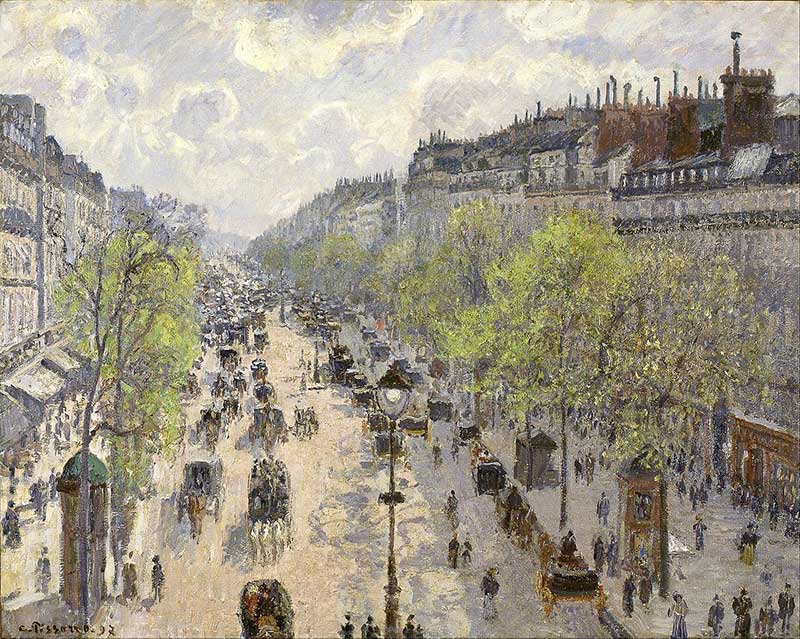
Later, in 1897, Pissarro produced his far more stately Boulevard Montmartre series of paintings. Learn more about them on our Boulevard Montmartre page.

